
While Ford and Toyota spent big on ads in 2022, Tesla went the opposite way. They spent just $152,000 on U.S. ads that year. This bold move helped Tesla shake up a $1 trillion industry that relied on TV ads and billboards.
So, how did Tesla make $18.2 billion in 2021 without using traditional ads?
Tesla’s success comes from turning customers into brand advocates. Elon Musk’s 107 million Twitter followers help spread the word about new products. Plus, referral programs reward users, like YouTuber Ben Sullins, who made $12 million from loyal fans.
This article shows how Tesla focuses on innovation over ads. They put all their resources into R&D, while others spent billions on commercials.
Understanding the Tesla Zero Ad Spend Strategy
Tesla’s Tesla Zero Ad Spend Strategy changes the game. Unlike others, Tesla doesn’t spend billions on ads. Instead, they focus on making cars so good, they sell themselves. This Tesla cost-effective marketing strategy boosts innovation, not just ad budgets. In 2021, Tesla made $44 billion without using traditional ads.
Overview of the Strategy
Here’s how it works: Zero ad dollars mean every vehicle’s design and tech must stand out. Toyota, for example, spent $495 per car on ads. Tesla uses that money for research and development. In 2021, Tesla spent $2.59 billion on R&D, making cars like the Model S Plaid go from 0-60 mph in under two seconds.
- R&D focus: $3,000 per car in tech vs. competitors’ $495 per car in ads
- Word-of-mouth engine: Referral programs reward customers with free Roadsters or charging credits, driving $12 million in sales from a single social media influencer
- Brand advocacy: Owners see themselves as part of a sustainability movement, not just buyers
By focusing on product excellence over ads, Tesla creates buzz that lasts. This approach lets them lead 14% of the global EV market. No need for billboards—just amazing tech.
The Role of Elon Musk in Marketing
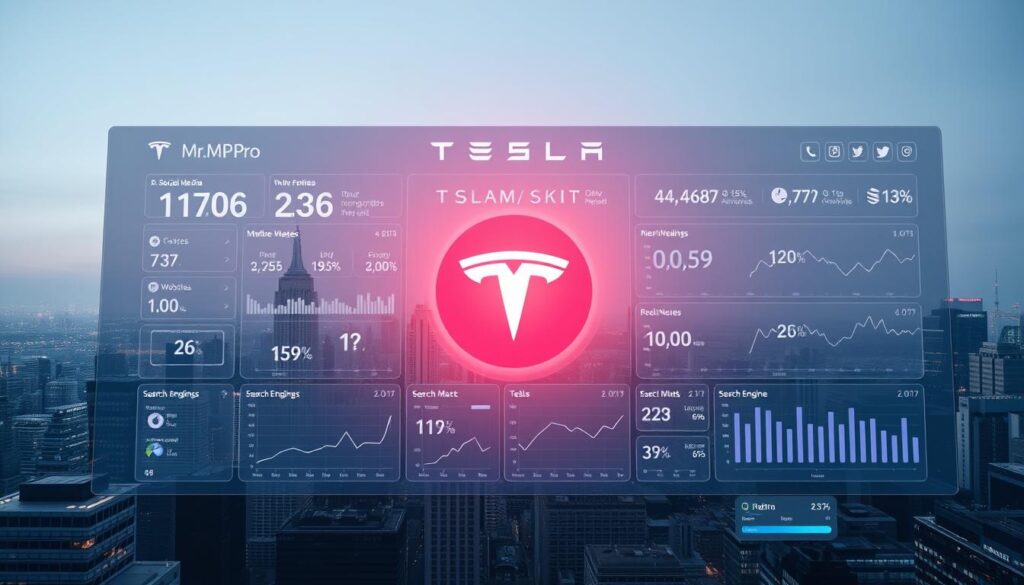
Elon Musk’s impact on Tesla online visibility is unmatched. His tweets and public image spread brand messages far and wide, without the need for Tesla digital advertising strategies. With over 200 million followers on X (formerly Twitter), Musk’s updates on new car features, production, or space ventures create a buzz worldwide.
Visionary Leadership and Its Impact
Musk’s leadership makes Tesla more than just a car company. It’s a movement driven by electric vehicles and sustainability. This resonates with consumers, fostering loyalty. Here are some key facts:
- 87% of Tesla owners stay loyal to the brand.
- 81% of new buyers come from other EV brands.
- No paid social media ads are used—ever.
This approach stands in stark contrast to competitors who spend millions on commercials.
Musk as a Social Media Influencer
Musk’s direct and honest style grabs attention. A single tweet can change stock prices or sell out car inventories. His 2018 Falcon Heavy launch with a Tesla Roadster as cargo? That was free media worth millions. Even controversies, like a 28% stock dip in 2022 after his Tesla/X merger tweets, keep Tesla in the headlines.
Musk’s strategy focuses on being real over polished ads. By connecting with fans directly—answering questions, sharing memes, or teasing prototypes—he creates a community. This makes Tesla more than just a car company; it’s a mission-driven brand. For marketers, Musk’s approach shows how leadership and organic digital engagement can replace expensivetraditional ad spend. Influence is the ultimate marketing tool.
Leveraging Word of Mouth for Brand Growth
Tesla’s success comes from its owners becoming its biggest fans. With Tesla organic reach fueled by loyal customers, the brand grows without ads. Features like Autopilot and “Romance Mode” create moments owners can’t wait to share.
This grassroots enthusiasm drives Tesla brand promotion. In fact, 99% of Model 3 owners say they’d recommend Tesla to others.
Importance of Customer Advocacy
High satisfaction leads to advocacy. Tesla’s Net Promoter Score (NPS) of 90+ shows owners are eager to share. Imagine a friend talking about their car’s instant torque or software updates.
These organic conversations are free yet powerful. Tesla’s referral program, which gave away 80 Roadsters, also encourages sharing.
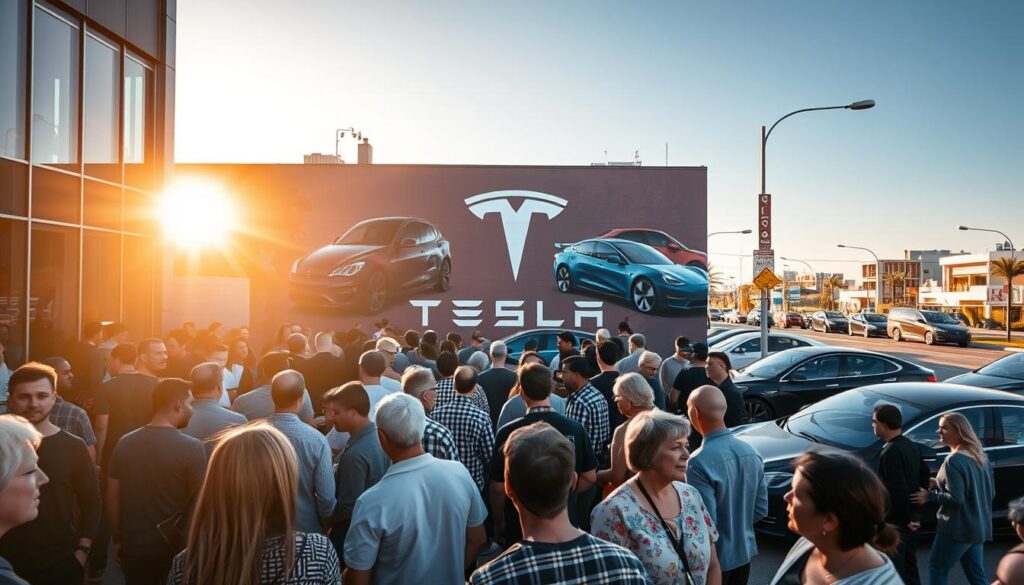
Creating a Community of Enthuasiasts
Buying a Tesla is more than just a purchase—it’s joining a movement. Tesla clubs and forums connect fans worldwide, building loyalty. Events like software update releases become social media highlights.
This keeps the conversation alive. The result? A community that markets itself through shared passion and innovation.
Social Media and Digital Presence
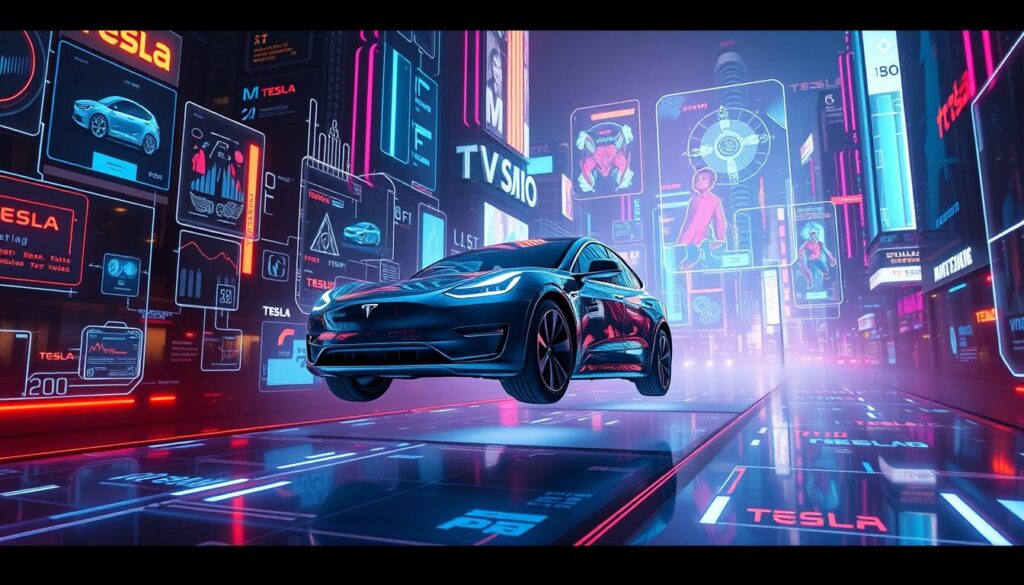
At the heart of Tesla’s Tesla digital advertising strategies is a focus on growing naturally. They skip traditional ads and use platforms like Twitter to stay in the spotlight. Elon Musk’s 26 million followers make his tweets marketing gold. This method saves money and boosts Tesla website traffic through real interactions.
Tesla’s Unique Use of Twitter
Musk’s tweets highlight new products and company achievements. They spark debates, making some moments go viral. For example, the Cybertruck window break incident became a big topic without any paid ads. Reddit’s r/teslamotors is full of user stories and tips, acting as free marketing.
Engaging Content That Drives Conversations
In 2017, Tesla’s “Project Loveday” campaign asked fans to make their own ads. Hundreds of videos flooded YouTube, sharing personal Tesla stories. This turned customers into creators, reducing the need for paid ads. Musk also talks directly with followers, building trust and sharing the brand’s values.
| Brand | YouTube | ||
|---|---|---|---|
| Toyota | 62% | – | – |
| Porsche | 14% | 47% | – |
| Audi | – | 54% | – |
| Tesla | 0% | Organic | 55% of social activity |
While BMW spends 20% of its budget on Twitter, Tesla focuses on community content. This approach saves money and builds a dedicated fan base. By choosing engagement over ads, Tesla shows digital presence can grow without big budgets.
Fostering a Strong Brand Identity
Tesla’s brand promotion is all about making the world use clean energy faster. This goal is at the heart of everything they do, from designing cars to helping customers. Tesla doesn’t use old marketing tactics. Instead, they build trust and loyalty by always saying the same thing and connecting with their community.
What makes Tesla stand out includes:
- A mission-driven vision: “Sustainable energy” is central to all communications.
- Consistent visuals: Minimalist design in stores, websites, and ads reinforces premium quality.
- Customer-first transparency: Open patent policies and real-time production updates build trust.

| Traditional Automakers | Tesla Approach |
|---|---|
| Heavy ad campaigns | No traditional ads; relies on organic word-of-mouth |
| Focus on specs and price | Emphasizes sustainability and innovation |
| Dealer networks | Direct sales model for controlled brand experience |
Tesla makes sure their message is the same everywhere. This means their website, app, and stores all share the same values. This unity makes customers feel connected and loyal, turning them into brand advocates.
As a result, Tesla has a worldwide community that supports the brand naturally. This community helps spread the word without needing paid ads.
Innovation as a Marketing Tool
Tesla’s Tesla marketing tactics focus on new product launches and tech achievements. Instead of ads, events like Battery Day and the Cybertruck reveal serve as free showcases. The 2019 Cybertruck launch, despite a mishap with Musk’s “armor glass” demo, saw a huge spike in sales.
Pre-orders went from 146,000 to 250,000 in just days. This shows that even mistakes can spark viral interest.
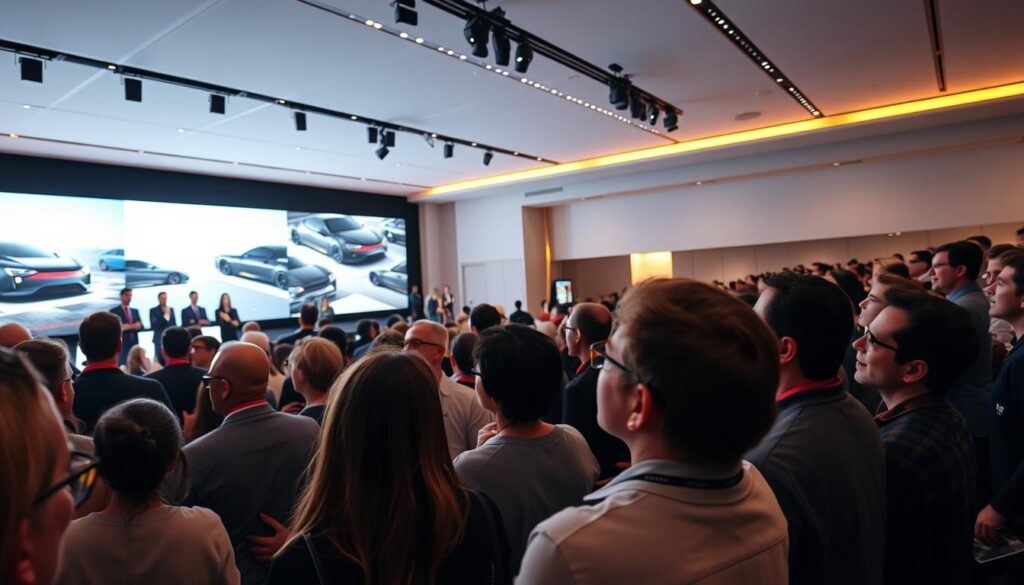
The Power of Product Reveal Events
- Battery Day and AI Day attract millions of viewers worldwide, with the Cybertruck’s debut reaching over 15 million.
- Live demos, even if they fail, become viral hits. The Cybertruck’s “failure” trended on social media, boosting Tesla’s reach.
- These events showcase Tesla’s leading role in sustainable innovation, like the 4680 battery cells.
How Innovation Generates Buzz
Every new feature gets its moment in the news. The Cybertruck’s stainless-steel design and “bioweapon defense mode” made headlines without paid ads. Musk’s Twitter posts about AI or car updates get millions of impressions daily.
Even controversies, like the SEC fine over his 2018 “funding secured” tweet, keep Tesla in the news.
“Innovation distinguishes between a leader and a follower.” — Steve Jobs
Tesla turns R&D into marketing magic. The “Dog Mode” update, inspired by customer feedback, became a hit. This mix of tech and transparency builds a loyal fan base.
By focusing on innovation, Tesla gets media coverage worth billions without spending on ads.
Cultivating Customer Loyalty
Tesla’s success comes from making owners lifelong fans. With 68.4% of customers showing loyalty, Tesla shows how strong bonds boost Tesla brand promotion and Tesla website traffic boost naturally.
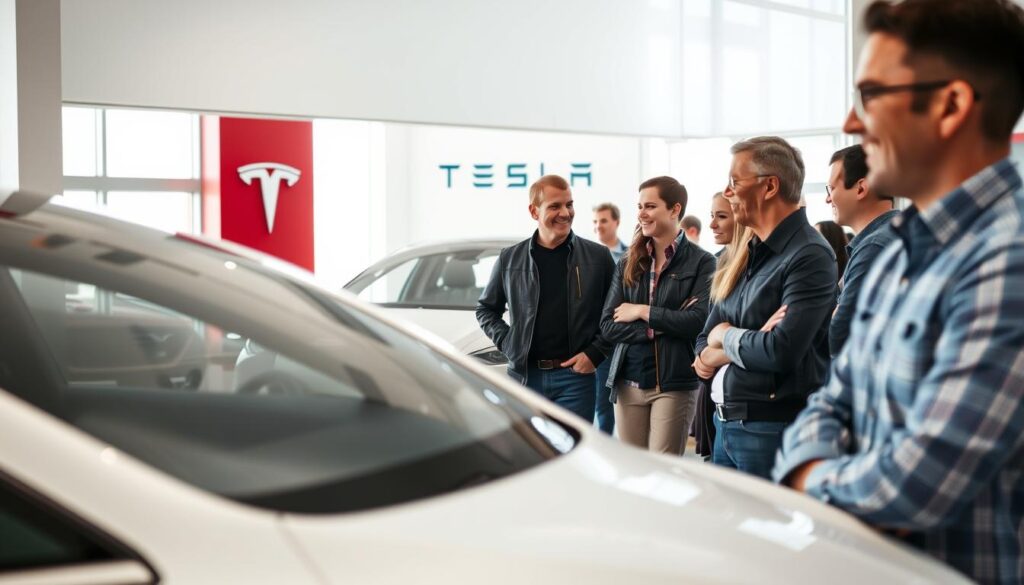
| Strategy | Impact |
|---|---|
| Software Updates | Free updates keep cars improving, keeping owners excited and sharing news online. |
| Personalized Service | Direct sales data lets Tesla offer tailored services, encouraging repeat visits to the website. |
| Community Events | Owner events and test drives build trust, leading to more web searches and referrals. |
| Referral Programs | A high Net Promoter Score means customers promote the brand, sending friends to Tesla’s site. |
Every update or event strengthens trust. When owners feel part of a movement, they check Tesla.com often and suggest it to others. This cycle of happiness and sharing cuts down on ad spending while growing traffic and loyalty.
Media Relationships and Public Relations
Tesla takes a unique approach to media and PR. They focus on bold storytelling instead of traditional press releases. In 2020, they got rid of their PR team. This move aimed to boost Tesla online visibility through Elon Musk’s social media and product updates.
This strategy is all about raw, honest messages. It encourages people to talk about Tesla, which helps with Tesla search engine optimization. This way, Tesla stays in the news, improving their online presence.
Managing Media Coverage
Tesla doesn’t have a traditional PR team anymore. They rely on big events like software updates and Elon Musk’s tweets. A tweet in 2022 caused a $14 billion drop in the market but got Tesla worldwide attention.
The company’s Tesla online visibility is all about contrasts. They have recalls in China and NHTSA probes, but also 90% customer satisfaction. This mix keeps Tesla in the headlines, helping them stay relevant online.
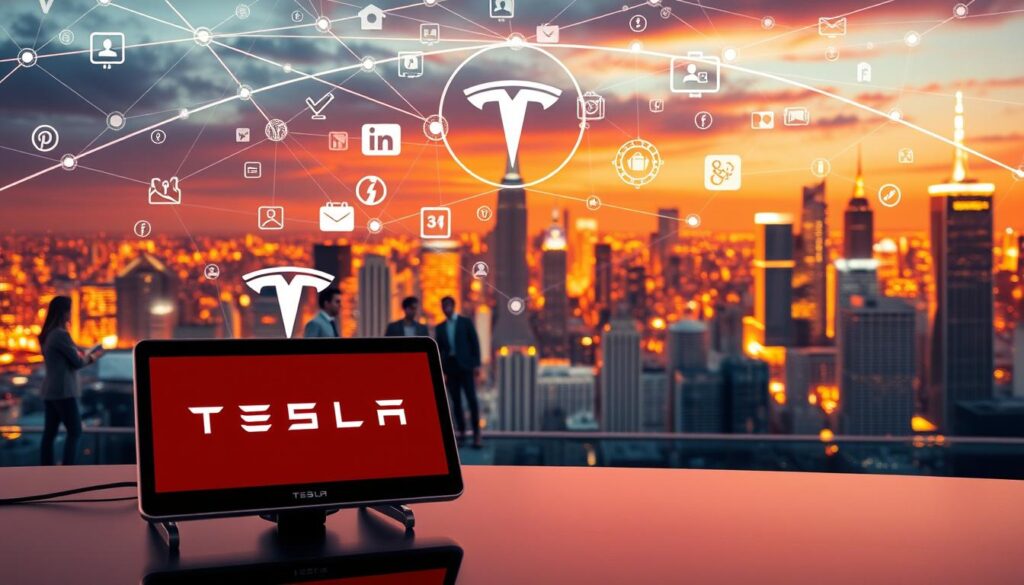
Using PR for Brand Amplification
Tesla’s media strategy is all about taking risks. By not scripting messages, Elon Musk’s comments and product reveals go viral. For example, his 2023 statement that
“Tesla’s Autopilot reduces accident rates by 10x”
started a big debate. This debate increased search traffic for Tesla.
Even negative news, like the Australia battery fire, helps Tesla. It sparks discussions that indirectly improve Tesla search engine optimization. This way, Tesla gets media attention without spending on ads.
The Impact of Product Reviews
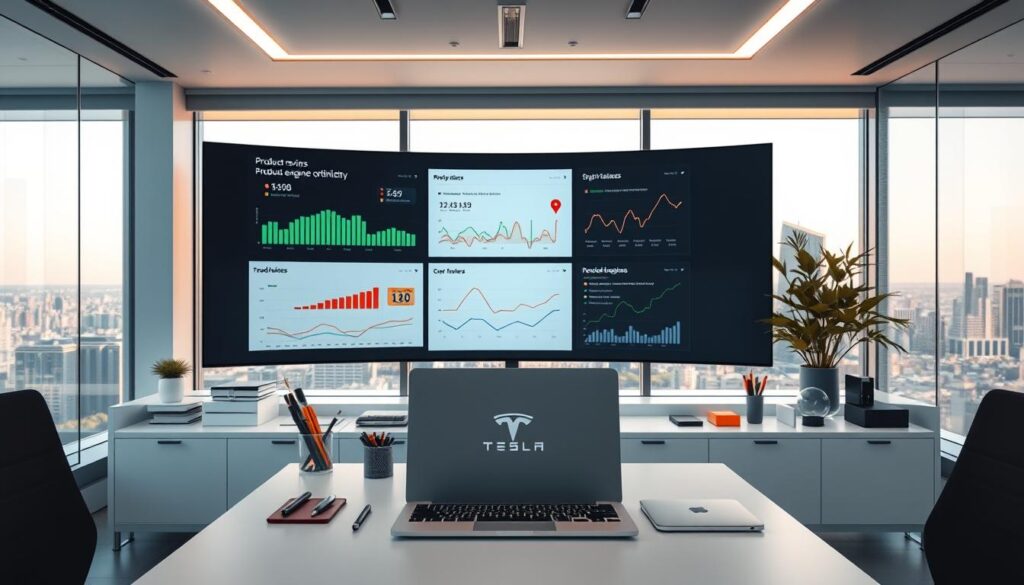
When people look for electric vehicles, they often rely on what others say. Tesla uses this to its advantage. It turns product reviews into a key part of its Tesla search engine optimization strategy. Positive feedback from experts and happy customers helps Tesla rank high in search results.
This approach boosts Tesla organic reach without needing to pay for ads.
“Digital rankings have the power to make or break brands today,” experts note. “Tesla’s strategy harnesses this to build credibility.”
Generating Organic Media Attention
Every good review of a Tesla Model S Plaid or Cybertruck is free marketing. Sites like MotorTrend and TechRadar share these stories, making Tesla’s content more visible. The Cybertruck’s 2020 reveal got millions of social shares, turning memes into free ads.
This cycle helps Tesla stay on top of searches for things like “best electric SUV” or “affordable EV.”
Leveraging Influencer Feedback
Influencers like Marques Brownlee and Grace Brown have reviewed Tesla vehicles. Their reviews, like Autopilot feature breakdowns, bring more traffic to Tesla’s site than ads. Musk’s 160M Twitter followers also help spread these reviews.
When critics praise Tesla’s range or design, it builds trust and drives sales. This happens without Tesla spending a marketing budget.
Building Anticipation and Hype
Tesla uses smart marketing to make product launches big events. The Model 3’s 2016 launch is a great example. It got 325,000 reservations in just a week, bringing in $14 billion in deposits without any TV ads. This shows how Tesla makes the most of limited offers and excitement to boost demand.
The Art of Unveiling New Products
Tesla starts with teasers and Elon Musk’s mysterious tweets. The Cybertruck launch is a perfect example. It got 200,000 orders in just 3 days after a dramatic reveal. Here’s how Tesla does it:
- Cryptic hints via Elon Musk’s 25M Twitter followers
- Live-streamed events with top-notch production
- Product reveal timelines that match fan guesses
Creating a Sense of Urgency
Scarcity tactics make customers act quickly. The “Not a Flamethrower” campaign sold 20,000 units in four days at $500 each. It shows the power of limited releases. Key strategies include:
- Limited release quantities for new models
- Regional rollout schedules that create excitement
- Deposit-based reservation systems that require immediate action
| Brand | 2022 U.S. Ad Spend |
|---|---|
| Tesla | $151,947 |
| Ford | $370M |
| Toyota | $1.1B |
| GM | $1.35B |
This approach gets a lot of media attention, like the Falcon Heavy launch. It got 2.3B impressions for under $100M. By focusing on events, Tesla turns every launch into a story worth sharing. This shows that innovative marketing can be done without big budgets.
The Power of Partnerships
| Partnership Type | Benefits | Examples |
|---|---|---|
| Battery Technology Partners | Innovation access + tech credibility | Panasonic for battery advancements |
| Charging Network Alliances | Infrastructure growth + brand placement | Hotels, restaurants with Tesla charging stations |
| Software Collaborations | Ecosystem expansion + user integration | Mobile app developers for Tesla app features |
These partnerships are win-win situations. For example, hotels with Tesla charging stations attract tech-savvy visitors. This benefits both the hotel and Tesla, as Tesla gets more charging spots.
Software partnerships also boost Tesla’sonline visibility. When Tesla teams up with a luxury tech brand, both brands’ followers increase. This approach is cost-effective and builds trust through endorsements.
Tesla’s partnerships show that smart alliances can replace expensive marketing. By picking partners that share its values, Tesla grows its reach without spending a lot.
Utilizing Events for Brand Exposure
Imagine making car deliveries into fun events. Tesla uses events to mix enjoyment with purpose. Their road trips and meetups create excitement without ads, showing events are key to their marketing.
The Tesla Road Trip Effect
Long drives show off car features and get media attention. For example, cross-country trips highlight range and reliability. Journalists and social media fans share updates, making these trips live demos of electric cars’ practicality.
- Delivery events with champagne and music turn purchases into milestones.
- Owner gatherings let enthusiasts share tips and bond over shared values.
- Road trips like the Cybertruck light show tour let fans customize displays, blending tech and community.
Engaging with Customers through Events
| Traditional Auto Marketing | Tesla’s Approach |
|---|---|
| Paid ads in print and TV | Free publicity via event experiences |
| Focus on dealerships | Global owner meetups |
| Static product displays | Interactive road shows and demos |
Events like Supercharger tours let people see charging infrastructure. This builds trust and shows Tesla’s commitment to sustainability. Even product reveals, like the Cybertruck’s unboxing livestream, go viral without paid ads.
By focusing on real experiences, Tesla turns events into organic marketing. These strategies show how Tesla promotes its brand through shared moments. These moments spark conversations and drive sales.
Data-Driven Decision Making
At Tesla, data is more than just numbers. It’s the key to growth. By tracking how customers use their cars and online, Tesla makes smart choices. Every action, question, and review helps shape new ideas and reach more people.
Analyzing Customer Feedback
Imagine knowing how drivers use your cars. Tesla does this with real-time data from its cars. This info shows which features people love or hate. For example:
- Battery usage patterns shape future energy solutions
- Autopilot engagement guides software updates
- Website behavior highlights content that boosts Tesla website traffic boost
Adapting to Consumer Preferences
Data also helps with Tesla search engine optimization. Tesla watches search trends and sales to pick the best content. A 2023 report showed blog posts about charging speed got 40% more views than regular product pages.
Elon Musk once said,
“Data is the new oil—it powers everything we build.”
Through A/B testing, Tesla makes its website better. Features like live supercharger maps and range calculators now get more search traffic. This boosts Tesla search engine optimization.
By using user data and testing, Tesla makes sure every update meets customer needs. This way, there’s no guessing involved.
The Role of Sustainability in Branding
For Tesla, sustainability is more than just a trend—it’s the core of Tesla brand promotion. They make eco-friendly practices a key part of their products and actions. This turns caring for the environment into a way to boost Tesla online visibility and keep customers coming back.
How Eco-Friendly Practices Attract Customers
Picture choosing a car that helps the planet and supports clean energy worldwide. Tesla makes this choice easy by:
- Creating solar panels and battery storage for more than just cars
- Building cars that don’t pollute, matching what people want
- Showing off factory innovations like water recycling and using green energy
| Initiative | Impact |
|---|---|
| Solar products | Creates a network of green energy solutions |
| Zero-emission vehicles | Attracts buyers seeking ethical choices |
| Factory sustainability | Builds trust through transparent practices |
Tesla’s Commitment to Green Energy
Elon Musk always talks about sustainability as Tesla’s main goal. This makes every purchase a step towards fighting climate change. The brand’s focus on solar, batteries, and electric cars turns buyers into advocates who share the message.
By focusing on green energy, Tesla shows how values can replace ads. Their story is not just about cars—it’s a movement. That’s why their Tesla online visibility grows without spending on ads.
Challenging Conventional Automotive Marketing
Tesla’s Zero Ad Spend Strategy changes how cars are sold. Instead of dealerships, Tesla has tech showrooms. These look like Apple Stores but sell cars.
This approach means no dealer markups or negotiable prices. It makes buying a car clear and simple.
Traditional car ads cost a lot of money. But Tesla uses digital ads to grow. In 2023, they spent $6.4M on ads, a small amount compared to others.
By 2023, Tesla made up 60% of U.S. EV sales. This shows that spending less on ads can lead to success.
- Direct sales cut out middlemen, reducing costs and confusion.
- Shoppers find prices fixed, avoiding haggling seen at conventional lots.
- Musk’s 160M Twitter followers amplify messages without paid promotions.
Engagement comes from community. The /r/teslamotors subreddit has 55K+ fans. They share tech updates and videos.
A single Autopilot demo video got 33.8K upvotes. This shows Tesla’s free organic reach. Tesla focuses on trust, not ads. Staff educate buyers, not push sales.
By not following industry norms, Tesla shows how tech and transparency build loyalty. Their customer advocacy, like the 2014 $1.5K ad, proves community marketing works. Even with recent layoffs, their referral program drives sales without traditional ads.
Measuring Success Without Traditional Ads
For Tesla, success isn’t about ad clicks or TV viewership. The company looks at metrics that show how customers engage and grow. From selling 50,000 vehicles in 2015 to over 1.8 million in 2023, Tesla’s website traffic boost and sales show its Tesla marketing tactics work. Even without spending on ads for 15 years, the Cybertruck got 600,000 preorders quickly, showing that live events can spark interest.
- Vehicle deliveries: A key indicator of market acceptance
- Website traffic trends: Tracking engagement with new models
- Social sentiment scores: Monitoring public perception
- Reservation conversion rates: Measuring buyer intent
Tesla compares its costs to rivals like GM, which spent $5 billion on ads in 2015. Tesla’s market value went past GM’s without traditional ads. Tesla recently spent $6.4 million on U.S. ads in 2023, but its main focus is on making better products. The Model Y becoming the world’s top-selling car in 2023 shows how good products can replace ads.
Brand health is checked through owner satisfaction and referral programs. When Tesla cut prices globally in 2024, it counted on customers to keep demand up. This is similar to P&G’s move to user-generated content, showing that earned media beats paid ads. Even with layoffs and slower sales, Tesla keeps its focus on what customers want, ensuring growth meets their needs.
Conclusion: Lessons from Tesla’s Strategy
Tesla’s Zero Ad Spend Strategy has changed how brands can succeed without ads. They focused on making great products and listening to customers. This led to a huge success, even with just $52 in ads in 2017.
When a brand’s mission matches customer values, it grows fast. This is a big lesson for companies wanting to cut down on ads.
Key Takeaways for Your Brand
Make products that people want to talk about. Tesla’s electric cars and fast speeds got everyone talking. Use referral programs and social media to grow your community.
Tesla has 2.29 million YouTube subscribers and Musk is active online. This shows how to reach more people without ads. Focus on being open and innovative, like Tesla’s direct sales model.
Even small brands can do this by focusing on customer experiences. Use what customers say to improve and show it off.
Final Thoughts on Modern Marketing Approaches
Ads are not the only way to market anymore. Tesla’s success shows that being true to your purpose is key. By making customers happy, Tesla’s reach has grown more than any competitor’s, even with big ad budgets.
Be real and share stories that matter, like Tesla’s green energy efforts. Host events and talk to people in real time. This approach is what today’s consumers want.
While not every company can be Tesla, the main idea is clear. Make products people love, listen to what they say, and let them spread the word. This is how you market in today’s world.

 Tesla Zero Ad Spend Strategy: How Elon Musk Built a Billion-Dollar Brand Without Traditional Ads
Tesla Zero Ad Spend Strategy: How Elon Musk Built a Billion-Dollar Brand Without Traditional Ads
0 Comment